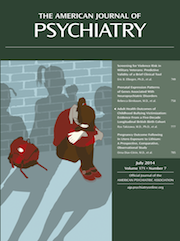Community Treatment for Violence in Released Inmates With Schizophrenia
To the Editor: The recent article by Keers et al. (1) on prisoners released to the community in England and Wales provides important research on the relationships between prisoners with serious mental illnesses, persecutory delusions, and violent incidents in the postrelease period. However, one of the conclusions reached by the authors does not seem supported by their data.
In their abstract, the authors conclude that “maintaining psychiatric treatment after release can substantially reduce violent recidivism among prisoners with schizophrenia.” But the rates given in Table 2 of the article for violent incidents, during the period of study, are nearly identical for inmates with schizophrenia who received treatment during incarceration and then either stopped or continued treatment after release (27.3% and 24.5%, respectively). Both rates are significantly lower than for prisoners who received no treatment (50%).
A conclusion, based on this data, is that community follow-up in the postrelease period, which typically includes continuation of pharmacotherapy, counseling, and case management, has little effect in reducing violence for inmates with schizophrenia—provided they received treatment in prison. This is contrary to commonly held beliefs (2, 3) and merited some discussion.
A message to be taken from this study, which the authors did not comment upon, is that correctional mental health professionals have reason to be hopeful that the treatment they provide to their patients with schizophrenia during incarceration can reduce violent incidents after prison, even when treatment does not continue.
1 : Association of violence with emergence of persecutory delusions in untreated schizophrenia. Am J Psychiatry 2014; 171:332–339Link, Google Scholar
2 : Understanding and preventing criminal recidivism among adults with psychotic disorders. Psychiatr Serv 2007; 58:773–781Link, Google Scholar
3 : Psychiatric disorders and repeat incarcerations: the revolving prison door. Am J Psychiatry 2009; 166:103–109Link, Google Scholar



